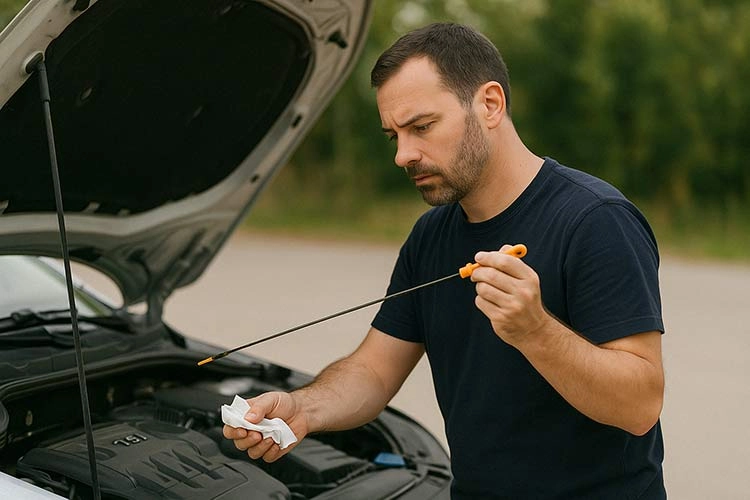
How Often Should I Change My Oil?
Knowing how often to change your oil is an important factor for keeping your vehicle engine running smoothly. Over the years the answer to this question has evolved and is not to be answered straight forward. The general information we get from manufactures has evolved, and depends on several factors. The type of oil you use, your driving habits, do you drive more urban or city, and the vehicle specs.
So, how often should you change your oil? What we get from car manufactures are often recommendations in the range between 7,500 to 10,000 miles (12070 to 16093 km) with synthetic oil or once a year. For conventional oil - typically 3,000 to 5,000 miles (4828 to 8046 km) or every six months. However, these numbers can vary depending on how you drive and where you live.
If you are still not sure, check your vehicle owner's manual, there should be an exact recommendation for oil service intervals. What I would recommend, if your vehicle is a newer generation after 2005, there should be an on-board computer service interval available. There you can actually check, when was the car last serviced.
If you are still here, and you are interested more about the oil service intervals, we will try to break down this article, some key questions: "How often should you check your oil?" and "Do I really need to change oil every 6 months?" We’ll explore the differences between synthetic and conventional oils and share tips on recognizing when it’s time for an oil change, regardless of mileage or time
Example Oil Change Intervals by Driving Condition
The table provides information on how often the engine oil is changed, based on the vehicle age, oil type, and the driving conditions.
| Driving Condition | Vehicle Age | Oil Type | Recommended Interval |
|---|---|---|---|
| Frequent Short Trips | Older Vehicles | Conventional | Every 3,000 to 5,000 miles (4,800 to 8,000 km) or 6 months |
| Frequent Short Trips | Older Vehicles | Synthetic Blend | Every 5,000 to 7,500 miles (8,000 to 12,000 km) or 6 months |
| Frequent Short Trips | Older Vehicles | Synthetic | Every 5,000 to 7,500 miles (8,000 to 12,000 km) or 6-12 months |
| Frequent Short Trips | Newer Vehicles | Conventional | Every 3,000 to 5,000 miles (4,800 to 8,000 km) or 6 months |
| Frequent Short Trips | Newer Vehicles | Synthetic Blend | Every 5,000 to 7,500 miles (8,000 to 12,000 km) or 6 months |
| Frequent Short Trips | Newer Vehicles | Synthetic | Every 5,000 to 7,500 miles (8,000 to 12,000 km) or 6-12 months |
| Stop-and-Go Traffic | Older Vehicles | Conventional | Every 3,000 to 5,000 miles (4,800 to 8,000 km) or 6 months |
| Stop-and-Go Traffic | Older Vehicles | Synthetic Blend | Every 5,000 to 7,500 miles (8,000 to 12,000 km) or 6 months |
| Stop-and-Go Traffic | Older Vehicles | Synthetic | Every 5,000 to 7,500 miles (8,000 to 12,000 km) or 6-12 months |
| Stop-and-Go Traffic | Newer Vehicles | Conventional | Every 3,000 to 5,000 miles (4,800 to 8,000 km) or 6 months |
| Stop-and-Go Traffic | Newer Vehicles | Synthetic Blend | Every 5,000 to 7,500 miles (8,000 to 12,000 km) or 6 months |
| Stop-and-Go Traffic | Newer Vehicles | Synthetic | Every 5,000 to 7,500 miles (8,000 to 12,000 km) or 6-12 months |
| Highway Driving | Older Vehicles | Conventional | Every 5,000 to 7,500 miles (8,000 to 12,000 km) or 6-12 months |
| Highway Driving | Older Vehicles | Synthetic Blend | Every 7,500 to 10,000 miles (12,000 to 16,000 km) or 6-12 months |
| Highway Driving | Older Vehicles | Synthetic | Every 7,500 to 10,000 miles (12,000 to 16,000 km) or 1 year |
| Highway Driving | Newer Vehicles | Conventional | Every 5,000 to 7,500 miles (8,000 to 12,000 km) or 6-12 months |
| Highway Driving | Newer Vehicles | Synthetic Blend | Every 7,500 to 10,000 miles (12,000 to 16,000 km) or 6-12 months |
| Highway Driving | Newer Vehicles | Synthetic | Every 7,500 to 10,000 miles (12,000 to 16,000 km) or 1 year |
| Extreme Temperatures | Older Vehicles | Conventional | Every 3,000 to 5,000 miles (4,800 to 8,000 km) or 6 months |
| Extreme Temperatures | Older Vehicles | Synthetic Blend | Every 5,000 to 7,500 miles (8,000 to 12,000 km) or 6-12 months |
| Extreme Temperatures | Older Vehicles | Synthetic | Every 5,000 to 7,500 miles (8,000 to 12,000 km) or 6-12 months |
| Extreme Temperatures | Newer Vehicles | Conventional | Every 3,000 to 5,000 miles (4,800 to 8,000 km) or 6 months |
| Extreme Temperatures | Newer Vehicles | Synthetic Blend | Every 5,000 to 7,500 miles (8,000 to 12,000 km) or 6-12 months |
| Extreme Temperatures | Newer Vehicles | Synthetic | Every 5,000 to 7,500 miles (8,000 to 12,000 km) or 6-12 months |
| Dusty or Humid Conditions | Older Vehicles | Conventional | Every 3,000 to 5,000 miles (4,800 to 8,000 km) or 6 months |
| Dusty or Humid Conditions | Older Vehicles | Synthetic Blend | Every 5,000 to 7,500 miles (8,000 to 12,000 km) or 6 months |
| Dusty or Humid Conditions | Older Vehicles | Synthetic | Every 5,000 to 7,500 miles (8,000 to 12,000 km) or 6-12 months |
| Dusty or Humid Conditions | Newer Vehicles | Conventional | Every 3,000 to 5,000 miles (4,800 to 8,000 km) or 6 months |
| Dusty or Humid Conditions | Newer Vehicles | Synthetic Blend | Every 5,000 to 7,500 miles (8,000 to 12,000 km) or 6 months |
| Dusty or Humid Conditions | Newer Vehicles | Synthetic | Every 5,000 to 7,500 miles (8,000 to 12,000 km) or 6-12 months |
| Hilly or Mountain Terrain | Older Vehicles | Conventional | Every 3,000 to 5,000 miles (4,800 to 8,000 km) or 6 months |
| Hilly or Mountain Terrain | Older Vehicles | Synthetic Blend | Every 5,000 to 7,500 miles (8,000 to 12,000 km) or 6-12 months |
| Hilly or Mountain Terrain | Older Vehicles | Synthetic | Every 5,000 to 7,500 miles (8,000 to 12,000 km) or 6-12 months |
| Hilly or Mountain Terrain | Newer Vehicles | Conventional | Every 3,000 to 5,000 miles (4,800 to 8,000 km) or 6 months |
| Hilly or Mountain Terrain | Newer Vehicles | Synthetic Blend | Every 5,000 to 7,500 miles (8,000 to 12,000 km) or 6-12 months |
| Hilly or Mountain Terrain | Newer Vehicles | Synthetic | Every 5,000 to 7,500 miles (8,000 to 12,000 km) or 6-12 months |
Why Oil Changes Are Important
Servicing your engine oil regularly is the simplest yet most impactful form of vehicle impact. Engine oil plays several critical roles in keeping your engine running efficiently and trouble free. We will break down exactly why oil is essential for longevity and performance.
Lubrication
The main role of a motor oil is to lubricate all the moving parts within the engine, such as pistons, and crankshaft. With proper lubrication, these components would grind against each other, leading to extensive wear and eventually damaging the engine. Keep in mind that those are the main two components in an engine.
So, when the oil gets old it loses its lubricating properties. Then the oil is less effective at reducing friction. In this unfortunate case, the engine can overheat and accelerate its wear, which could ultimately lead to costly repairs or even engine failure.
Cooling
The engine of a vehicle generates a lot of heat as it is running, and while the cooling system handles most of the work of keeping the engine at operating temperature and preventing it from overheating. The motor oil plays a vital role in helping to keep the temperature in check. By circulating through the engine, oil absorbs some of the heat and carries it away from critical components.
Over time, engine oil loses its ability to regulate temperature effectively. The oil becomes thick or contaminated, and it has the counter effect by trapping the heat rather than dissipating it, leading to overheating issues that put extra strain on the engine.
Cleaning
Engine oil helps to clean the engine by picking up dirt, debris, metal particles while circulating. Then the dirt is transported to the oil filter, where the filter traps the trash, and prevents re-entering the engine. With every oil change it is really important to change the Oil Filter, otherwise it is like 50% of the service.
If regular oil changes are skipped, the oil filter becomes clogged. The oil becomes thick and sludgy. This contaminated oil can then deposit grime back into the engine, clogging passages, and reducing the efficiency of the oil flow. This buildup not only impacts performance but can also lead to expensive repairs over time.
Protection Against Corrosion
Over time, motor oil can become contaminated with acids and other byproducts from fuel combustion, which can corrode engine parts. Quality motor oils contain additives that help neutralize these harmful acids, offering a level of protection against rust and corrosion.
However, as the oil ages, these additives lose effectiveness. By changing your oil on schedule, you’re ensuring that the oil remains fresh and capable of protecting the internal engine components from corrosion.
Improved Fuel Efficiency
As mentioned above the engine oil helps the lubrication of the engine, when the motor oil is old and degraded, then the engine has to work harder to overcome the added friction. That means it has to burn more fuel, which lowers the fuel efficiency. The fresh oil allows the engine to operate smoothly. Although the difference may seem small, maintaining regular oil changes can lead to noticeable fuel savings over time, especially for those who drive frequently or cover long distances.
Extending Engine Life
One of the most significant benefits from regular on point oil changes is the role they play in extending the overall lifespan of your engine. By ensuring that your engine remains well-lubricated, free of contaminants, and protected from excessive heat and corrosion, you’re effectively reducing the chances of premature engine failure.
If the engine is serviced on time and the oil used is actually good, the probability to exceed over 200,000 miles (~320,000km) without significant engine issues is high. An oil change is a small investment compared to the cost of major engine repairs or, worse, a complete engine replacement.
Factors Affecting Oil Change Frequency
There is no concrete number of miles/km that determines the best time to change your oil. The intervals are dependent on various factors. Such as: vehicle age, the type of oil, and the driving conditions. In this section, each factor will be explained.
Vehicle Age
Older Vehicles: Older vehicles, especially those manufactured before the 2000s, often have less advanced engine technology and may benefit from more frequent oil changes. In general, older cars can require an oil change every 3,000 to 5,000 miles (4828 to 8046 km) or every 6 months, whichever comes first.
Newer Vehicles: Modern engines are designed to operate efficiently with less frequent oil changes, especially when using synthetic oil. Many newer vehicles can go 7,500 to 10,000 miles (~12000 to 16000 km) or even up to a year between oil changes, depending on the manufacturer’s recommendations. Always consult the owner’s manual to find the recommended interval for your vehicle.
Driving Habits
Frequent Short Trips: If most of your drives are short (less than 5 - 10 miles 8 - 20km) per trip, your engine may not be able to reach its optimal operational temperature. That can lead to condensation to be built up in the oil, leading to sludge formation. For frequent short trips, recemented oil service is every 3,000 to 5,000 miles (4828 to 8046 km) to keep the engine clean.
Stop-and-Go Traffic: If you regularly drive in heavy traffic with lots of idling and stop-and-go movements, your engine works harder and builds up heat more quickly. This type of driving is considered severe, which can lead to oil degradation faster. In this case, changing the oil every 5,000 miles or every 6 months is recommended.
Highway Driving: Vehicles that primarily drive on highways at steady speeds are typically easier on motor oil. This type of driving is less demanding on the engine, allowing oil to last longer. For highway drivers, oil changes may only be necessary every 7,500 to 10,000 miles (~12000 to 16000 km), especially when using synthetic oil.
Environment and Climate
Extreme Temperatures: Driving in extremely hot or cold conditions can strain the engine oil. If too hot oil can thin, reducing its capability to lubricate. If too cold, the oil might become too tick, making it harder to circulate. Here is an good article how to know what oil to use for different climates
Dusty or Humid Conditions: If you often drive on dusty roads or in humid environments, particles and moisture can infiltrate your engine, contaminating the oil faster.For drivers in these conditions, following a shorter oil change interval—like every 5,000 miles 8046 km—may help protect the engine.
Oil Type (Conventional vs. Synthetic)
Conventional Oil: Conventional oil is derived from crude oil and contains fewer additives, which makes it more prone to breaking down under high-stress conditions. As a result, conventional oil generally requires more frequent changes, typically every 3,000 to 5,000 miles (4828 to 8046 km), or about every 6 months.
Synthetic Oil: Synthetic oil is engineered to withstand higher temperatures and resist breakdown better than conventional oil. It is formulated to last longer and perform well under extreme conditions. Most synthetic oils can safely go 7,500 to 10,000 miles (~12000 to 16000 km) between changes. If you’re wondering how often to change synthetic oil, you can usually go longer than you would with conventional oil, depending on your driving habits and conditions.
Synthetic Blend: A synthetic blend, which is a mix of conventional and synthetic oils, offers a middle ground. It provides some of the benefits of synthetic oil but is typically less expensive. You can expect synthetic blend oils to last around 5,000 to 7,500 miles, depending on usage and driving conditions.
Signs You Need an Oil Change
There might be symptoms that you need to change your oil, except the regular oil change interval. Paying attention to those symptoms can prevent engine damage. So, how often should you change your oil? Ideally, once a month, or before a long distance road trip, can help you catch an early sign and address any issue before becoming severe. Here are some symptoms that you need to pay attention to.
Noisy Engine or Knocking Sounds
If you start hearing your engine working roughly, that might be an indication that either there is some major problem with it, or simply the oil has lost its lubrication or oil breakdown.
Oil Change or Check Engine Light
Many modern vehicles have a dashboard light specifically for oil changes. If this light—or the broader "check engine" light—comes on, it may indicate that the oil needs to be changed or that there’s an oil pressure issue.
Dark, Dirty, or Gritty Oil
Fresh oil is amber and translucent. Over time, oil accumulates dirt, debris, and metal particles, causing it to turn dark and thick. This reduces its ability to flow smoothly and lubricate effectively.
Low Oil Level
Regularly checking the oil level using the dipstick can reveal if the oil is running low. If you find yourself frequently topping off the oil, it could be a sign of a leak or that the oil is burning too quickly.
Excessive Exhaust Smoke
It’s normal for exhaust to be somewhat translucent, but if you notice thick or dark smoke coming from the tailpipe, it may be a sign of an oil issue.
Smell of Burning Oil Inside the Vehicle
If you smell burning oil inside your vehicle, it can indicate that oil is leaking onto hot engine parts or that the oil is old and breaking down.
Poor Fuel Economy
If you notice that you’re filling up the gas tank more often than usual, it may be because the oil in your engine is old and thick, causing the engine to work harder than necessary.
Engine Overheating
Overheating can be a serious warning sign. While there are several potential causes of overheating, one common reason is oil that can no longer effectively dissipate heat from the engine.
By paying attention to these signs, you can stay ahead of potential issues and ensure your engine is always well-protected.
FAQs on Oil Changes
How Do I Know When My Oil Needs Changing?
If you notice a dashboard warning light, dark or gritty oil on the dipstick, or your car's engine seems sluggish, it’s likely time for an oil change.
Can I Switch Between Conventional and Synthetic Oil?
Yes, you can switch between conventional and synthetic oil, but check your vehicle’s manual or ask a mechanic to ensure it’s right for your car.
What Happens If I Don’t Change My Oil?
Neglecting oil changes can lead to increased engine wear, overheating, and potentially costly repairs due to engine damage.

